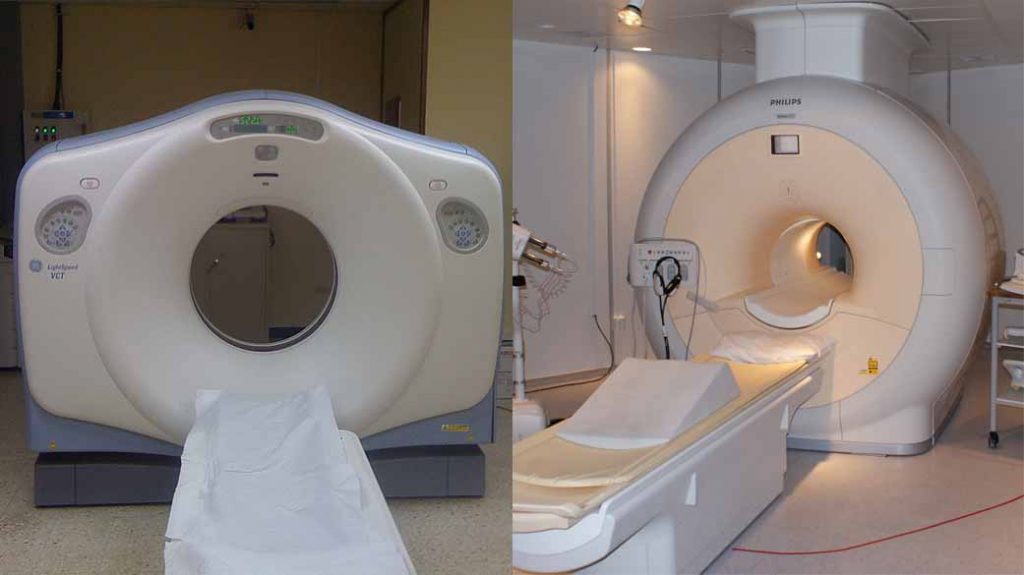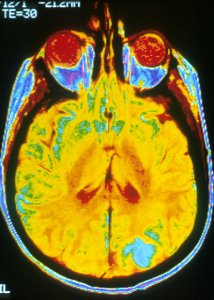CT Scan vs MRI Scan: What’s the Difference?

A CT scan is faster and less noisy than an MRI scan, but it uses nuclear radiation and is not as good at recording soft tissues in high definition.
What is the difference between a CT scan and an MRI scan? The long answer is that there are a lot of differences, even though both machines look a lot alike at first glance. (Above is a CT and an MRI from left to right.) CT scanners and MRI machines differ by use, safety, cost, length of time, and more.
CT Scan vs MRI Scan
Uses of CT vs MRI
The acronym in CT scan, or CAT scan, stands for Computerized Axial Tomography. The work by means of an x-ray beam that travels in a circular motion around the patient’s body. Then the computer program puts all of the different x-rays together into a 3D image of the inside of the patient’s body.
MRI is short for Magnetic Resonance Imaging. These machines are basically giant magnets that electrically charge the atoms inside the patient’s body and then capture a detailed image of it. MRI scans are more precise images that are better for inspecting soft tissue in more minute details than a CT scan can achieve.
Safety of CT vs MRI
CT scans use a series of x-rays, which contain small doses of radiation. According to the medical community, these small doses are not enough to affect a patient’s health. But they will not let anyone else in the CT scan room with you, due to the danger of absorbing the excess radiation. Pregnant women and very young children should not have a CAT scan, because the radioactivity may negatively affect the infant.
In a CT scan, you are more likely to be given a contrast agent, such as barium sulfate, which may cause queasiness, vomiting, diarrhea, and cramping insensitive stomachs. Sometimes the radiation dye is injected through a shot, which stays in your body for 48 hours, and in rare cases, it causes allergic reactions.
Most MRI-related accidents are caused by magnetic objects. The scanner works by means of a powerful magnet that provides magnetic resonance imaging. As soon as it turns on any metallic objects in the area will be powerfully attracted to the magnetic force issuing from inside. There have been cases where patients were accidentally crushed by oxygen cylinders that were suddenly sucked into the bore during MRI procedures.
Patients that have medical devices implanted in their body, such as pacemakers, aneurysm clips, and even metal shavings in the organs, cannot have an MRI done because it could damage their internal tissues. Occasionally someone will wear clothing with metallic fibers such as activewear and it will cause a burning sensation during the scan. People with a lot of tattoos may feel a sensation of intense heat because tattoo ink contains particles of metal.
Many patients suffer from MRI claustrophobia. They may suffer from an anxiety attack mid-scan because it’s hard to sit still inside an enclosed area for up to an hour while it makes loud scanning sounds all around you. But the technologist should be trained to handle patient stress if that happens.
Cost of CT vs MRI
An MRI scan costs several times more than a CT scan because the equipment is much more expensive. The average price for a CAT scan is anywhere from $200 to $1600. But an MRI scan will cost $500 to $14,000 depending on what state or country you live in, and where you get it done.
If you are sick or injured and need imaging quickly, it is less costly for the doctor to order a CT procedure. However, if they need to examine you in detail to make a diagnosis, an MRI scanner would be better because of the clarity and detail in which it renders images. This makes it easier to spot irregularities.
An MRI scan costs a lot more because they are very expensive to purchase and maintain. A brand new MRI machine from the original manufacturer sells for $1.5 to $3 million. It also needs a special suite that has absolutely no magnetic objects inside, and a separate control room for the radiologist to work in.
If you move around during an MRI the picture will get all distorted like painting a picture. This is called an imaging artifact. Imaging artifacts are bad because they often result in re-scans. That means the patient has to go through the entire process a second time and pay for it again as well.
If the patient requires contrast imaging dye, or sedatives, then the cost of an MRI procedure mounts dramatically. Anesthesia may cost $500 to $3,500 per use, depending on how what type they use and who you see.
Time for CT vs MRI
An MRI scan takes an average of 30 minutes to an hour. The procedure can be a stressful experience because you have to sit still for over half an hour. Furthermore, the MRI machine is very loud and makes noises similar to a giant copying machine the entire time. So it seems longer than it really is unless you are unconscious.
A CT scan is a short process when compared to getting an MRI done. It’s also much quieter. If you don’t need contrast dye beforehand the procedure can be done in 15 minutes to half an hour. If you do need the dye, then you have to arrive an hour early to drink it and let it settle.
A CT scanner and an MRI machine have a similar appearance, but they work very differently. Basically, you can go for the small dose of radiation that costs a lot of money, or the powerful magnetic field that costs twice as much money but delivers a clearer picture. And one is much noisier than the other.
If you are prone to MRI anxiety or know someone that is then consider the MRI Stereo by Sound Imaging. Melt your fears away by playing your music of choice during the scanning process. It’s already in use by hospitals and imaging centers around the world. Or consider the MRI Visor, an immersive entertainment experience.



